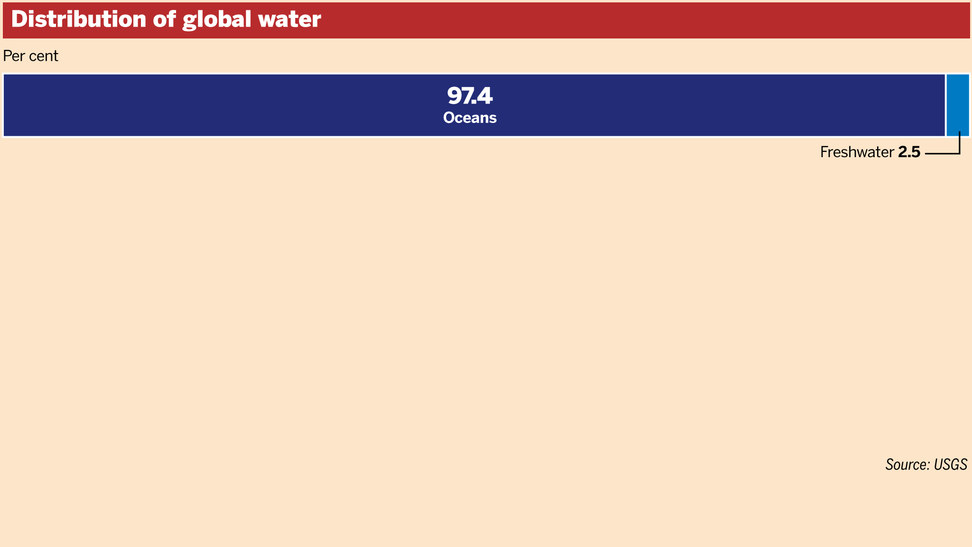© The Financial Times Ltd 2016
FT and 'Financial Times' are trademarks of The Financial Times Ltd.
The Financial Times and its journalism are subject to a self-regulation regime under the FT Editorial Code of Practice.
July 14, 2014 7:25 pm
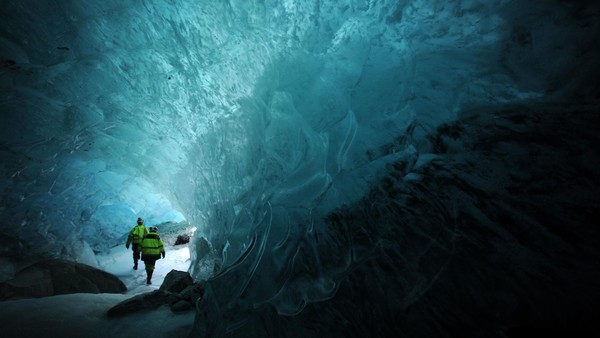 ©EDF@Pascal Tournaire
©EDF@Pascal TournaireThe River Nar, a minor waterway about 100 miles north of London, is barely known to the average Briton. And at first glance, it is hard to understand why a brand-conscious company such as Coca-Cola would want to have anything to do with it.
Some of the Nar bears an unhappy resemblance to a ditch, thanks to decades of re-routing that have left it so straight and narrow its murky waters can be crossed in a single step. Unlikely as it may seem in soggy Britain, it also suffers from a lack of water because outdated licensing rules have allowed it to become overused.
But the river is significant to Coca-Cola because it flows through an area that supplies a large chunk of the sugar beet the company uses to sweeten the drinks it sells in the UK. Fertiliser run-off from farms has contributed to the Nar’s troubles.
Coca-Cola knows that these sorts of problems can pose a risk to its business. Eleven years ago one of its bottling plants in India was subjected to angry protests over its impact on local water supplies and eventually closed. It has long insisted the accusations were unfair.
But since 2003 Coca-Cola and its bottlers have spent nearly $2bn to reduce their water use and improve water quality wherever they operate. That spending now extends to a sodden field next to the Nar, surrounded by clumps of stinging nettles and the odd goat, where the company recently paid for something very unusual to be done to improve the river. It gave £1.2m to the World Wildlife Fund conservation group, which has dug a winding channel to restore a straight stretch of the river back to a meandering version of its older, natural self.
“It’s definitely not your average conservation project,” says Rose O’Neill, WWF water programme manager, explaining that the scheme and other related work Coca-Cola has funded will help the river clean itself and tackle water scarcity.
Coke’s nearly $2bn in investments may sound big but in fact they are a small example of how much companies are starting to spend on water worldwide. Nearly 20 years after the World Bank began warning of a looming water crisis, the combination of a surging population, a growing global middle class and a changing climate is straining water supplies. For companies – from multinational corporations to small businesses – this amounts to higher costs for a resource that has long been taken for granted.
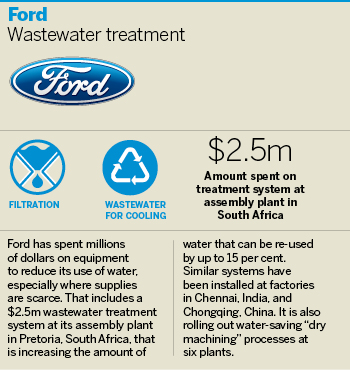
“The marginal cost of water is rising around the world,” says Christopher Gasson, publisher of Global Water Intelligence. “Previously, water was treated as a free raw material. Now, companies are realising it can damage their brand, their credibility, their credit rating and their insurance costs. That applies to a computer chipmaker and a food company as much as a power generator or a petrochemicals company.”
Examples of these costs abound:
● Nestlé, one of the world’s biggest food companies, set aside SFr38m ($43m) for water-saving and wastewater treatment facilities at its plants last year.
● In Australia a subsidiary of BG Group, the British oil and gas company, has launched a A$1bn ($938.7m) water monitoring and management system that will pipe treated water from its gasfields to boost water supplies for farmers and towns.
● Antero Resources, a US shale gas company, plans to spend $525m on a pipeline to carry water to its operations, boosting the reliability of its supplies.
● Rio Tinto and BHP Billiton have launched a $3bn desalination scheme in Chile that will pump treated seawater up 10,000ft to a jointly owned copper mine, cutting their use of fragile local water supplies.
● Ford, the carmaker, has built a $2.5m water treatment system at its Pretoria assembly plant in South Africa that is increasing water reuse up to 15 per cent. “We see it as definitely an emerging issue that we feel we need to address,” says John Viera, global head of sustainability.
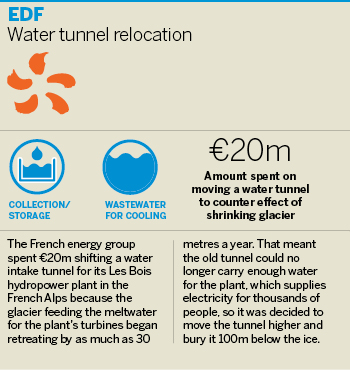
● EDF, the French energy group, has spent €20m shifting a water intake tunnel for one of its hydropower plants in the French Alps because the glacier feeding the meltwater for its turbines retreated so much the old tunnel could no longer capture enough water. “Water management is not only a developing country issue,” says Claude Nahon, the company’s head of sustainable development.
Since 2011 companies have spent more than $84bn worldwide to improve the way they conserve, manage or obtain water, according to data from Global Water Intelligence, regulatory disclosures and executive interviews with the Financial Times.
The reasons for each investment differ. Some are driven by physical water shortages, others by new industrial processes requiring water in greater quantities or of higher quality. Other companies want to show customers they care about water conservation. Some are motivated by new environmental regulations requiring better wastewater treatment.
The $84bn figure is neither comprehensive nor easy to compare with past spending levels. This is because companies are generally not required to disclose capital or operating costs for water-conservation measures. While some businesses highlight water investments in their sustainability reports, relatively few disclose the price of such schemes.
The bottom line
Google, for example, declines to say how much it spent on a plant it has built at one of its data centres in the US state of Georgia, which enables it to use diverted sewer water to keep its servers cool. Nor has it disclosed how much it spends at a Belgian data centre that uses water from an industrial canal.
Previously, water was treated as a free raw material. Now, companies are realising it can damage their brand, their credibility, their credit rating and their insurance costs
- Christopher Gasson, Global Water Intelligence publisher
Joe Kava, the company’s head of data centre operations, has warned that water is “the big elephant in the room” for tech companies, which can typically use hundreds of thousands of gallons of water a day. “We’ve been focusing on power consumption and energy efficiency and that’s excellent,” he said in 2009. “I think the next thing we need to turn our attention to is what do we do about the looming water crisis?” As water becomes more scarce, data companies’ use of it could attract public scrutiny, he added, possibly resulting in regulations governing how much water they consume.
Google told the FT last week that its focus on water conservation means it now has a facility in Finland cooled entirely by seawater. It is also looking at using captured rainwater in South Carolina.
Regulation is a growing concern for many companies, which is a reason investors are starting to press for more disclosure about water risks.
Norway’s huge $890bn oil fund, the world’s biggest sovereign wealth fund, is one of several large investors urging companies to improve their reporting. It cites what Jan Thomsen, its chief risk officer, has described as “increasing water scarcity and adverse water-related events” that could affect its long-term returns.
The fund is one of 530 investors with $57tn in assets that work with the Carbon Disclosure Project, an international environmental charity. On behalf of those investors, CDP asks large companies each year to disclose the risks and opportunities water poses for their business. Last year 70 per cent of the 180 FTSE Global 500 companies that responded said water was a substantive risk to their business, up from 59 per cent in 2011.
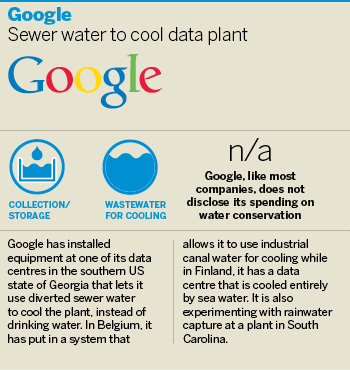
A similar trend has emerged in the most recent edition of the World Economic Forum’s annual global risk survey of business executives and other leaders. Water supply crises were not rated among the five biggest concerns in terms of impact in any year up to 2011, but have been among the top three listed every year since 2012.
Water scarcity is no longer just a small, plant-level issue for companies but has become a strategic question for senior management, says Martin Stuchtey of McKinsey, the consultancy. “It’s capturing a larger part of the capital expenditure bill at many companies,” he says. The $550bn global water market – which covers everything from water treatment plants to pipelines – is expanding at about 3.5 per cent a year, he adds. But it is growing much faster in some industries: as high as 14 per cent a year for the oil and gas sector and 7 per cent for the food and beverages industry.
Mining matters
Those rising costs are most visible for one business sector: mining. The industry’s spending on water has increased from $3.4bn in 2009 to nearly $10bn in 2013 and is likely to exceed $12bn this year, according to Global Water Intelligence.
It says BHP Billiton and Rio Tinto’s $3bn desalination scheme for their Escondida copper mine in Chile was a record for an industry in which water infrastructure has traditionally accounted for about 10 per cent of a mine’s cost, but has recently reached as much as 30 per cent. At least seven other mining groups in the country have drawn up plans for smaller desalination plants worth a combined $1bn. Water scarcity is such a concern that Chilean legislators have been discussing a measure requiring miners to desalinate their water instead of drawing on local supplies.
More plants are also planned for mines in neighbouring Peru, where the industry has had its own version of Coca-Cola’s troubles in India: in 2011 the $1bn Tía María copper mining project run by US-based Southern Copper was halted after violent protests by farmers about its water use left three people dead. Other projects have been dogged by similar troubles.
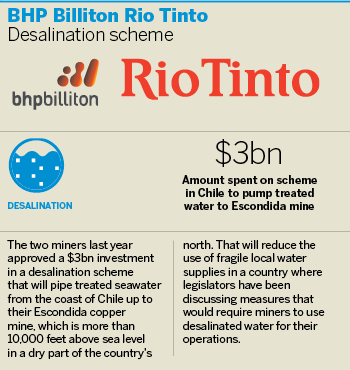
Nonetheless, Rio Tinto, the junior partner in the Escondida mine, plays down suggestions that water shortages are an unmanageable financial problem. “We haven’t felt it as being a significant trend for the business, but it is a material risk that we are managing,” said Matthew Bateson, Rio Tinto’s global head of environment.
Still, some experts are less relaxed. “It’s plainly true that water scarcity is finally starting to bite financially,” says Andrew Metcalf, an investment analyst and author of a 2013 report for Moody’s, the credit rating agency, that was among the first to warn of the financial impacts water shortages have begun to pose for the mining industry.
Mr Metcalf believes miners are not the only ones at risk. “Regulators in markets where oil and gas groups, chemicals companies and others operate have massively tightened the rules, and thus costs of compliance, regarding water usage in the last three to five years,” he says. “In the past, companies could do a project and spend more money on water if a problem later arose. Now, they have to have a plan showing how they won’t affect local water supplies before they can start operating.”
Costs are likely to keep rising according to Mr Metcalf’s report, because 70 per cent of the six biggest global miners’ existing mines are in countries where water stress is rated as a high or moderate risk, along with two-thirds of projects being developed.
The result is “projects will take longer to complete, be costlier and riskier, with credit-negative implications for the entire industry”.
Managing water scarcity
One executive with little doubt about the rising costs of water is Peter Brabeck, chairman of Nestlé. He has been at the forefront of corporate efforts to draw attention to water scarcity, a problem he believes is still not taken as seriously as it needs to be. “Humankind is running out of water at an alarming pace,” he says. “We’re going to run out of water long before we run out of oil.”
Water scarcity is a far more pressing problem than climate change, he says, but receives much less political attention than it should. “We have a water crisis because we make wrong water-management decisions,” he says. “Climate change will further affect the water situation but even if the climate wouldn’t change, we have a water problem and this water problem is much more urgent.”
One reason water receives less attention is that, unlike global warming, there is no such thing as a global water crisis. Instead, there are a series of regional predicaments in a world where the distribution of fresh water is so lopsided that 60 per cent of it is found in just nine countries, including Brazil, the US and Canada, according to the UN.
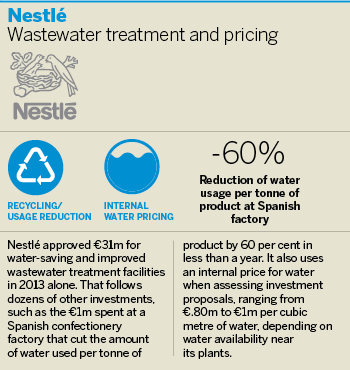
Another reason the problem persists, insists Mr Brabeck, is that water is so undervalued that it is typically used inefficiently – and there is not enough investment to boost supplies.
As the chairman of a leading bottled water seller, whose brands include Perrier and Poland Spring, he has drawn fire for this view from activists opposed to any form of water privatisation. He also agrees the provision of water for drinking and basic needs is a human right. Still, Nestlé has taken an unusual approach to valuing water by introducing an internal “shadow price” for it that is used by the company when assessing proposals to buy new equipment to improve the efficiency of how water is used in its factories. The price is just over $1 per cubic metre for sites where there is abundant water and about $5 in drier spots.
Such a move makes good business sense for a company such as Nestlé. Its coffee, cereals and milk products sit on breakfast tables worldwide, meaning it has a global reputation to protect. It is also the 49th-biggest industrial consumer of water in the world, according to Global Water Intelligence.
That makes it far more vulnerable to customer boycotts than the biggest water consumer, China Guodian, a power generator, which has captive customers and is barely known outside its own country.
That vulnerability is one explanation for the water investments at many companies, not least Coca-Cola, which ranks as the 24th-biggest industrial consumer of water and is one of the world’s most recognisable brands. The closure of its bottling plant in India galvanised awareness of water risk at many drinks companies. “It was certainly something that had a lot of impact for us,” says Greg Koch, Coca-Cola’s director of global water stewardship. He adds that it showed the company needed an “emotional licence” to water, on top of regulatory permission. “I don’t mean emotional in a perjorative sense, like emotional baggage. I mean it in the sense that water is spiritual, it’s religious, it’s visceral, it’s daily. Everyone has a first memory of water; you don’t have a first memory of a carbon offset credit.”
Farms versus industry
For all the accusations of water hogging made against Coke or any other business, however, industry comes a very distant second to the world’s biggest water users: farmers.
Agriculture accounts for 70 per cent of all water use compared with 22 per cent for industry and just 8 per cent for domestic users, says the UN.
These proportions vary by country but the problem water scarcity poses for businesses in many parts of the world is that shortages pit the two biggest users, farmers and factories, against each other.
In Iran, farmers last year smashed a pipeline they said was diverting water to factories in a nearby city. In Australia, farmers have formed a movement against coal seam gas drilling they claim will damage water supplies. And in India, which accounts for more than 30 per cent of the increase in global water withdrawals over the past 15 years, farmer protests over water have been aimed at companies ranging from coal-power generators to soft-drink makers. Another Coca-Cola bottler, this time in the north of India, was temporarily closed last month after local farmers complained about its water use.
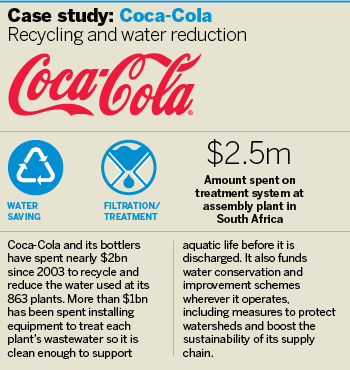
The number of water-related conflicts reported worldwide has surged in the past 15 years, according to the Pacific Institute, a water research group. US intelligence officials have also raised concerns about the risk of conflict over water. “We assess that during the next 10 years, water problems will contribute to instability in states important to US national security interests,” said a 2012 intelligence report prepared for the US State Department.
That report highlighted the risk to global food markets from the rapid depletion of one crucial source: groundwater.
Just over 97 per cent of the world’s water is in its oceans. Of the 2.5 per cent that is fresh water, almost 70 per cent is locked away in glaciers and ice caps and about 1 per cent is in lakes, rivers and other surface water sources. The remaining 30 per cent is groundwater, some of it so ancient and hard to replace it is known as fossil water.
Drilling deep
Less than a century ago relatively little groundwater was used. But as the global population surged, driving up food demand, it led to a boom in extraction that began in a few countries such as Spain and the US but has now spread worldwide.
An estimated 2bn people rely on groundwater for drinking and irrigating crops but its use is often unregulated and poorly monitored. This means more is pumped out than can be replenished quickly when it rains.
In the US groundwater levels around California’s Central Valley farming area have been declining rapidly. Between 2003 and 2010, a volume of water almost equal to that in the country’s largest reservoir, Lake Mead, was lost, according to a study led by Jay Famiglietti of the University of California who uses Nasa satellite data to monitor depletion.
In the Middle East, countries including Iran and Syria lost an amount almost equal to the Dead Sea over a similar period, mostly because of groundwater pumping.
But in terms of the severity of the depletion, northwestern India is the worst, says Prof Famiglietti. Water-hungry farms and rapid population growth mean that between 2002 and 2008, the region’s aquifers lost an amount of water nearly three times the maximum Lake Mead can hold.
Globally, pumping out so much groundwater has contributed to a “small but not trivial” increase in sea levels as the extracted water eventually makes its way to the oceans, according to Leonard Konikow of the US Geological Survey, a leading groundwater expert.
The politics of agriculture are such that no politician is ever going to remove subsidies for farmers, whether it’s in California or anywhere else
- Scott Rickards, Waterfund founder
At the heart of the groundwater problem is a host of regulatory deficiencies that companies alone can do little to change, including subsidised water for impoverished farmers that governments are loath to touch. “The politics of agriculture are such that no politician is ever going to remove subsidies for farmers, whether it’s in California or anywhere else,” says Scott Rickards, founder of the US Waterfund group, which develops financial risk-management products for the water industry.
One company acutely aware of the dilemma is SABMiller, one of the world’s biggest brewers. It has paid millions of dollars to conserve and improve its own water supplies, including $6m to upgrade pipes and other equipment at one of its plants in Tanzania affected by deteriorating water quality. At another of its facilities in the Indian state of Rajasthan, however, groundwater is disappearing so fast it has become “quite a significant risk to the brewery”, says Andy Wales, the company’s head of sustainable development.
SABMiller has invested in several measures to boost supplies, and it replaces more water than it draws out every year. Still, “that’s not enough to solve the problem because the farmers are still using it”, he says, noting that irrigation water is typically so cheap it is used inefficiently. SABMiller pays about 50c for each cubic metre of water it uses in South Africa, for example, while the farmers irrigating the barley used in its beer can pay half of 1 per cent of that price for the same volume of water.
“The only solution for companies really is to understand those local risks; dramatically improve efficiency and engage with local communities, governments and others to put in place projects that protect the watershed for all users.”
The cost of such measures is unlikely to fall as the world’s population becomes bigger, and richer.
Energy shocks
By 2030, the global population is expected to have increased from today’s 7bn to 8bn. The global middle class, meanwhile, is likely to have surged from nearly 2bn to 5bn, according to the OECD, largely in fast-growing Asian economies. Like their predecessors in developed countries, they are likely to want a hamburger, not just a bowl of vegetables, and the UN has calculated it takes 2,400 litres of water to produce a hamburger compared with less than 30 litres for a potato or a tomato. They will also want air-conditioning, televisions and other devices requiring electricity, on top of family cars and overseas holidays, all of which require more energy.
Water is needed for almost every aspect of energy production, from digging up fossil fuels to refining oil and generating power, and the amount of water consumed by the sector is on track to double within the next 25 years, according to the International Energy Agency.
In the Middle East, Royal Dutch Shell and Qatar Petroleum have built Pearl, the world’s biggest plant for converting gas to liquid fuels. The Qatar plant includes a groundbreaking water recovery and treatment system that Shell says eliminates the use of local water supplies. Shell declined to divulge the price but Global Water Intelligence estimates it cost $640m.
Water is needed for almost every aspect of energy production, from digging up fossil fuels to refining oil and generating power, and the amount of water consumed by the sector is on track to double within the next 25 years
“It’s a huge project,” says Laurent Auguste, director of innovation and markets at Veolia, the French water services group, which helped design and build the system. “It’s definitely something that you probably would not have thought of years ago but something that is absolutely critical.”
Water supplies are crucial for one of the energy industry’s most vibrant sectors: the booming US shale industry. The hydraulic fracturing, or fracking, process used to extract shale gas and oil typically requires about 2m gallons of water or more at each well. That has prompted concern among groups such as Ceres, a sustainable investor group, which says nearly half the US wells drilled since 2011 are in areas of high or extremely high water stress.
But the shale industry is only one part of the energy sector confronting water scarcity, says Tara Schmidt of Wood Mackenzie, the energy industry analyst. “This is no longer a ‘could be’ issue, this is a forefront issue,” she says. “Most energy companies definitely recognise they are under increasing scrutiny from governments and the public about how they use their water supplies.”
The risk is evident in China, where it has become mandatory in some regions for coal-fired power plants to be cooled with air instead of water. Installing an air-cooling system costs about $100m at an average-sized plant, say industry analysts, and also reduces efficiency because the plant needs to burn more coal to produce electricity to operate the system. This also produces more of the carbon dioxide responsible for climate change, underlining the difficult environmental trade-offs posed by the issue of water scarcity.
Desalination is another way that water scarcity is inadvertently leading to greater use of energy, thanks to the soaring increase in the number of plants that need electricity to operate. Forty years ago there were hardly any desalination plants. Today there are more than 17,200 producing a volume of water equal to just over 21 years of rain in New York, says the International Desalination Association.
Most energy companies definitely recognise they are under increasing scrutiny from governments and the public about how they use their water supplies
- Tara Schmidt, Wood Mackenzie
They are no longer confined mostly to the deserts of the Middle East either. The top 10 countries, in terms of online desalination volume capacity, include Spain, Australia and China, and companies are one reason why. Since 2010 45 per cent of new plants have been ordered by industrial users such as power stations and refineries, up from 27 per cent in the previous four years, the IDA says.
The trouble is, desalinated water is typically more expensive than water from other sources and, as climate scientists repeatedly warn, wet areas will become wetter and drier regions more parched, the prospect of these costs rising seems certain.
What can be done?
The solution to water scarcity is largely in the hands of governments, not companies, because it requires policies such as better regulation of irrigation groundwater or more intelligent use of wastewater.
Some states have shown how this can be done. Israel and Singapore have water recycling and management measures widely regarded as models. But such examples are relatively scarce and that has led some businesses to take matters into their own hands.
A group of companies including Nestlé and Coca-Cola has joined forces with the International Finance Corporation, the World Bank’s private investment arm, to form the 2030 Water Resources Group, a body trying to highlight the dimensions of the water scarcity problem and the least costly way of tackling it. It has produced sobering reports, including one showing demand for freshwater is likely to outstrip global supply by about 40 per cent by 2030 unless more is done to improve supply and stop inefficient use.
But some types of action make much more financial sense than others, according to another report from the group last year by Arup, the engineering consultancy. Plugging leaks at an existing water supply system, for example, can address water scarcity 50 to 100 times more cost effectively than building an expensive water treatment plant.
Solutions to water scarcity, in other words, are known and do not need to be that expensive. The risk a growing number of business leaders fear, however, is that such steps will be deferred until the last minute, forcing a costly scramble for action.
“If we don’t tackle this water issue we are going to run out of water,” says Nestlé’s Peter Brabeck, “and then we will start to try to make decisions which are not always necessarily the best ones.”
Next: How China’s dams are causing tensions along the Mekong river. In Saturday’s FT Weekend Magazine.
-------------------------------------------
Letter in response to this article:
Regulate fresh water use with foresight / From Mr Edward Davey
Copyright The Financial Times Limited 2017. You may share using our article tools. Please don't cut articles from FT.com and redistribute by email or post to the web.


